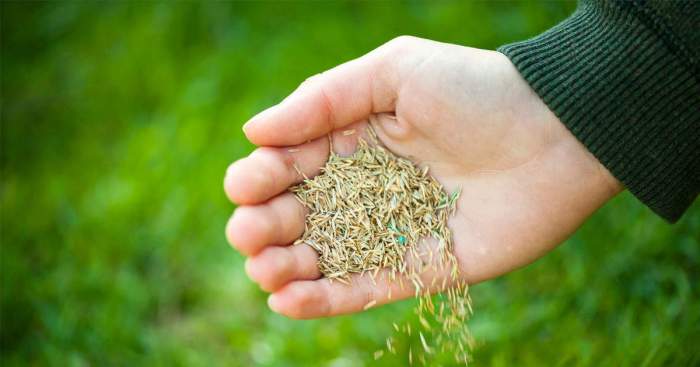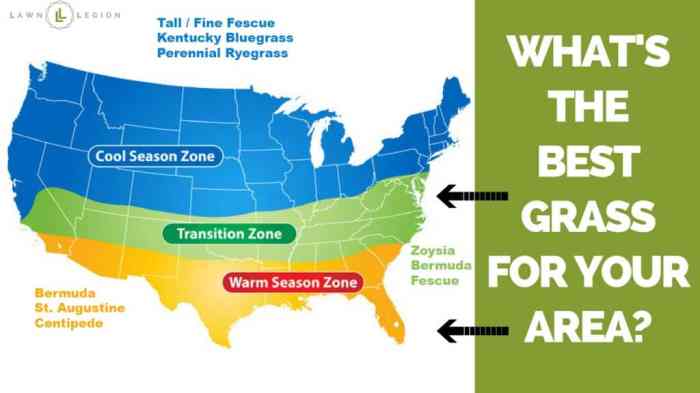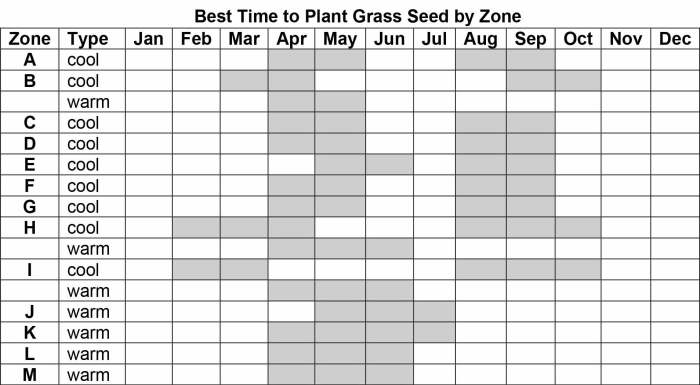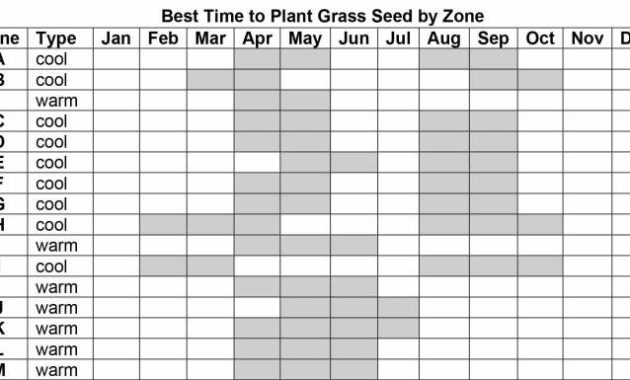Ideal Temperatures for Grass Seed Germination

Best month to plant grass seed – Successful grass establishment hinges critically on optimal soil temperatures. Germination, the initial sprouting of the seed, is a particularly sensitive phase, heavily influenced by the warmth of the surrounding soil. Understanding the ideal temperature range for different grass types is paramount for achieving a lush, healthy lawn. Variations in temperature can significantly impact germination rates, influencing the speed and success of the entire process.
Soil temperature is not uniform across depth; surface temperatures fluctuate more dramatically than those at lower levels. This fluctuation, coupled with the specific temperature requirements of individual grass species, dictates the timing of seeding and the ultimate success of the lawn establishment process. Consequently, understanding both the ideal temperature range and methods for monitoring soil temperature are essential for achieving optimal germination.
Optimal Soil Temperatures for Common Grass Types
The following table provides a general overview of the minimum, ideal, and maximum soil temperatures (in degrees Celsius) conducive to germination for several common grass types. These are approximate ranges, and actual requirements may vary slightly depending on factors such as soil moisture and seed quality. It’s crucial to remember that consistently maintaining the ideal temperature range maximizes germination success.
| Grass Type | Minimum Temperature (°C) | Ideal Temperature (°C) | Maximum Temperature (°C) |
|---|---|---|---|
| Kentucky Bluegrass | 10 | 20-24 | 30 |
| Tall Fescue | 10 | 18-24 | 28 |
| Perennial Ryegrass | 5 | 15-20 | 25 |
| Zoysia | 18 | 24-29 | 35 |
Impact of Soil Temperature Fluctuations on Germination Rates
Significant deviations from the ideal temperature range, whether too high or too low, negatively impact germination rates. Temperatures below the minimum can slow or completely halt germination, while excessively high temperatures can damage the seed or emerging seedling. For example, prolonged exposure to temperatures above the maximum can lead to seed desiccation and reduced viability, resulting in patchy or sparse lawn growth.
Conversely, prolonged periods below the minimum temperature can delay germination, increasing the risk of fungal diseases or competition from weeds.
Fluctuations also affect the uniformity of germination. Inconsistent temperatures can lead to uneven emergence, resulting in a less uniform lawn. This is particularly problematic for areas with significant microclimatic variations, such as slopes or areas with varying levels of shade.
Methods for Monitoring Soil Temperature at Different Depths
Accurate soil temperature monitoring is crucial for successful grass seed germination. Several methods exist to achieve this. Soil thermometers, available at most garden centers, provide direct measurements. These thermometers are typically inserted into the soil to the desired depth. For deeper measurements, specialized probes are available.
These probes can measure temperatures at various depths, providing a more comprehensive understanding of the soil temperature profile.
Alternatively, some weather stations incorporate soil temperature sensors. These stations provide continuous monitoring and data logging, allowing for a detailed analysis of soil temperature trends over time. This information can be invaluable for adjusting seeding timing and watering practices to optimize germination success. Regular monitoring, particularly during critical germination periods, helps ensure the soil remains within the optimal temperature range for the chosen grass species.
Sunlight Exposure and Grass Seed

The success of establishing a healthy lawn hinges significantly on understanding and meeting the sunlight requirements of the chosen grass species. Different grasses thrive under varying light conditions, and selecting an inappropriate variety for a given site can lead to poor germination, weak growth, and ultimately, a patchy or failing lawn. Matching the grass type to the sunlight exposure is a crucial step in lawn establishment.Sunlight profoundly influences the photosynthetic process in grass, impacting its growth rate, density, and overall health.
Insufficient light can result in weak, spindly growth, while excessive sunlight can scorch and desiccate the young seedlings, hindering establishment.
Sunlight Needs of Different Grass Varieties, Best month to plant grass seed
The sunlight needs of grasses vary considerably. A careful assessment of the sunlight conditions in your yard is paramount before selecting a grass seed blend. The following categorisation provides a general guideline:
- Sun-Loving Grasses: These varieties, such as Kentucky bluegrass ( Poa pratensis) and tall fescue ( Festuca arundinacea), require at least six hours of direct sunlight daily. They tolerate full sun and exhibit optimal growth under these conditions. Their deep root systems allow them to withstand drought conditions better than shade-tolerant grasses. In areas with less than six hours of sunlight, these grasses may struggle, becoming thin and weak.
- Partial Shade Grasses: Fine fescues ( Festuca spp.) and some ryegrasses ( Lolium spp.) perform well in areas receiving four to six hours of sunlight daily. These grasses are more tolerant of shade than sun-loving varieties but still benefit from adequate sunlight for vigorous growth. They are a suitable choice for areas with dappled shade from trees or buildings.
- Shade-Tolerant Grasses: Grasses like creeping red fescue ( Festuca rubra) and hard fescue ( Festuca longifolia) are specifically adapted to low-light conditions. They can thrive in areas receiving less than four hours of direct sunlight. However, even these shade-tolerant varieties benefit from some sunlight; completely shaded areas may still result in poor growth.
Impact of Insufficient or Excessive Sunlight on Grass Seed Growth
Insufficient sunlight inhibits photosynthesis, leading to slow growth, weak stems, and a susceptibility to diseases. Seedlings may become etiolated (leggy and pale) as they stretch towards available light. This results in a thin, sparse lawn that is easily outcompeted by weeds. Conversely, excessive sunlight, particularly during the establishment phase, can scorch and dehydrate young seedlings, preventing germination or killing established plants.
The intense heat can cause the soil to dry out quickly, further stressing the seedlings. This often manifests as browning or burning of the leaf blades.
Choosing the Right Grass Type Based on Sunlight Availability
Choosing the correct grass type is crucial for lawn success. Begin by accurately assessing the sunlight conditions in your yard. Observe the area throughout the day, noting the periods of direct sunlight and shade. Use a simple sun map or a sunlight app to aid in determining the average daily sun exposure. Once the amount of sunlight is determined, select a grass variety that matches those conditions.
For instance, a south-facing slope receiving full sun all day would be ideal for a sun-loving grass mix, whereas a north-facing area under the shade of trees would be better suited to a shade-tolerant grass. Consider consulting with a local garden center or landscaping professional for personalized recommendations based on your specific climate and soil conditions.
Soil Preparation and Planting Techniques: Best Month To Plant Grass Seed
Establishing a lush, healthy lawn begins long before scattering the seed. Proper soil preparation is paramount to successful germination and vigorous growth. Neglecting this crucial step can lead to patchy growth, weed infestation, and ultimately, a disappointing lawn. The following steps ensure a fertile foundation for your new grass.
Effective soil preparation involves a multifaceted approach, addressing factors such as compaction, nutrient levels, and weed control. A well-prepared seedbed provides optimal conditions for seed-to-soil contact, essential for efficient germination and root establishment. This process is not merely about tilling the soil; it’s about creating an environment conducive to thriving grass.
Soil Preparation Checklist
The following checklist Artikels the key steps involved in preparing the soil for grass seed planting. Each step contributes to creating a seedbed that promotes healthy growth and minimizes potential problems.
- Clear the Area: Remove all debris, rocks, and existing vegetation. This ensures uniform soil conditions and prevents competition for resources.
- Test the Soil: A soil test will reveal the pH level and nutrient content. This information guides the application of necessary amendments, such as lime to raise pH or fertilizer to supplement nutrients.
- Amend the Soil: Based on the soil test results, incorporate organic matter, such as compost or peat moss, to improve soil structure, drainage, and nutrient retention. This enriches the soil and provides a more hospitable environment for grass roots.
- Till the Soil: Loosen the soil to a depth of approximately 4-6 inches using a tiller or garden fork. This improves aeration and allows for better root penetration. Avoid over-tilling, as this can damage soil structure.
- Level the Soil: Create a smooth, level surface to ensure uniform seed-to-soil contact. This prevents uneven germination and growth. A garden rake is useful for achieving a consistent surface.
- Remove Existing Weeds: Persistent weeds will compete with grass seedlings for nutrients and water. Thorough weed removal before planting is essential for a healthy lawn.
Grass Seed Dispersal Methods
Two primary methods exist for distributing grass seed: broadcasting and drilling. Each offers distinct advantages and disadvantages, making the choice dependent on the size of the area, desired level of precision, and available resources. The selection of the appropriate method significantly influences the uniformity and density of the resulting lawn.
Broadcasting involves scattering seed evenly over the prepared soil surface. This method is suitable for smaller areas and requires less specialized equipment. However, it can lead to uneven seed distribution, potentially resulting in patchy growth. To mitigate this, many recommend a two-pass approach, scattering half the seed in one direction and the remaining half perpendicularly.
Drilling utilizes a seed drill to plant seeds at a specific depth and spacing. This technique ensures a more uniform seed distribution and depth, leading to more consistent germination and a denser lawn. Drilling is particularly advantageous for larger areas and situations requiring precise seed placement, although it requires specialized equipment.
Yo, so like, the best month to plant grass seed is def spring, right? But before you even THINK about that, you gotta figure out your landscaping game plan. Check out this link for info on how far apart to plant pine trees if you’re planning on adding some to your yard, because spacing is totally key.
Then, once you’ve got the trees sorted, you can totally focus on that lush green lawn and get back to planting your grass seed in the spring.
Raking and Covering Grass Seed
After seed dispersal, gentle raking and covering are critical steps. This ensures adequate seed-to-soil contact and protects the seeds from birds and other elements. The depth of covering is crucial for successful germination, with too much or too little soil hindering the process. A light covering is essential for optimal germination rates.
Gently rake the seed into the soil to a depth of about ¼ to ½ inch. Avoid burying the seeds too deeply, as this can hinder germination. After raking, lightly roll the area with a lawn roller to improve seed-to-soil contact and create a uniform surface. This compacting action helps ensure even moisture distribution and promotes better germination.
Factors Affecting Grass Seed Germination
The successful germination of grass seed is a complex process influenced by a multitude of interacting environmental factors. Understanding these factors and their impact is crucial for achieving a healthy, thriving lawn. While optimal conditions are necessary, even slight deviations can significantly affect germination rates and overall seedling vigor. This section will examine the key environmental factors that influence grass seed germination success, outlining both their positive and negative effects, and suggesting mitigation strategies where appropriate.
Environmental Factors Influencing Grass Seed Germination
The interplay of various environmental factors determines the success or failure of grass seed germination. These factors can be broadly categorized into those related to weather, soil conditions, and biological interactions. Their combined effect dictates the overall viability and establishment of the new lawn.
| Factor | Positive Impact | Negative Impact | Mitigation Strategies |
|---|---|---|---|
| Rainfall | Provides essential moisture for seed imbibition and germination; aids in nutrient uptake. Adequate rainfall ensures consistent soil moisture, promoting uniform germination. | Excessive rainfall can lead to waterlogging, reducing oxygen availability to seeds and causing rotting. Insufficient rainfall results in desiccation, preventing germination. Erratic rainfall patterns can lead to uneven germination. | Implement irrigation systems for consistent moisture delivery, particularly during dry periods. Improve soil drainage to prevent waterlogging. Use drought-tolerant grass species in arid climates. |
| Wind | Can aid in seed dispersal, particularly for lightweight seeds. Gentle breezes can promote seed-soil contact. | Strong winds can dislodge newly sown seeds, reducing germination rates. Wind can also cause soil erosion, exposing seeds and reducing moisture retention. Desiccation from strong winds can hinder germination. | Sow seeds during periods of calm weather. Use windbreaks (e.g., straw mulch) to protect seeds. Consider heavier seeds or those with better anchoring mechanisms. |
| Temperature | Optimal temperatures promote rapid and uniform germination. Each grass species has an ideal temperature range for germination; deviations from this range can significantly affect germination rates. | Temperatures that are too high can lead to seed desiccation and death. Temperatures that are too low slow down or prevent germination entirely. Extreme temperature fluctuations can also be detrimental. | Sow seeds during the optimal temperature range for the chosen grass species. Use soil covers to moderate temperature fluctuations. Consider sowing seeds at a depth that provides better temperature insulation. |
| Pests | (Generally, no positive impact) | Birds, rodents, and insects can consume seeds, reducing germination rates. Some insects can damage seedlings after germination. | Use seed protectants or repellents. Protect seeds with netting or other barriers. Time planting to avoid peak pest activity. |
Soil pH and Grass Seed Germination
Soil pH plays a critical role in grass seed germination. The pH level influences nutrient availability, affecting the seed’s ability to absorb essential minerals for growth. Most grasses prefer a slightly acidic to neutral pH range (between 6.0 and 7.0). A pH outside this range can limit the uptake of nutrients like phosphorus and iron, which are vital for seed germination and seedling development.
For instance, in highly acidic soils (pH below 5.5), aluminum toxicity can inhibit root development, hindering germination. Conversely, alkaline soils (pH above 7.5) can lead to deficiencies in iron and manganese, again impacting germination success. Soil testing to determine the pH level is crucial, and soil amendments, such as lime (to raise pH) or sulfur (to lower pH), can be used to adjust the pH to the optimal range before seeding.
This ensures that the essential nutrients are readily available for the germinating seeds, maximizing the chances of successful establishment.
Choosing the Right Grass Seed

Selecting the appropriate grass seed is paramount to establishing a lush, healthy lawn. The choice hinges on several interconnected factors, primarily climate and desired lawn characteristics. A careful consideration of these factors will ensure a successful and aesthetically pleasing outcome, minimizing future maintenance headaches and maximizing the longevity of your lawn.The selection process necessitates understanding the fundamental differences between grass types and their inherent properties.
This knowledge empowers homeowners to make informed decisions, aligning their seed choice with their specific needs and environmental conditions.
Cool-Season Versus Warm-Season Grasses
The primary division in grass seed selection lies between cool-season and warm-season grasses. This distinction is crucial because it directly relates to the optimal growing temperatures for each type. Choosing the wrong type will result in a struggling, unhealthy lawn.
- Cool-Season Grasses: These thrive in cooler temperatures, typically germinating and growing best in spring and fall. They tolerate shade better than warm-season grasses. Examples include Kentucky bluegrass, fine fescue, perennial ryegrass, and tall fescue. These are generally better suited for northern climates or regions with significant seasonal temperature variation.
- Warm-Season Grasses: These grasses flourish in warmer temperatures, with optimal growth occurring during summer months. They often require more sunlight than cool-season varieties. Examples include Bermuda grass, Zoysia grass, Centipede grass, and St. Augustine grass. These are ideal for southern climates with long, hot summers.
Grass Seed Characteristics to Consider
Beyond the basic cool-season/warm-season distinction, several other characteristics should guide your seed selection. These properties directly impact the overall health, appearance, and maintenance requirements of your lawn.
- Drought Tolerance: In arid or water-restricted areas, selecting drought-tolerant grasses is essential. These grasses possess physiological adaptations that allow them to survive with less frequent watering. Examples include Buffalo grass and certain fescue varieties.
- Wear Resistance: For high-traffic areas, such as play areas or heavily used walkways, selecting wear-resistant grasses is crucial. These grasses can withstand foot traffic and recreational activities without significant damage. Certain blends of Kentucky bluegrass and perennial ryegrass are known for their durability.
- Growth Habit: Grasses exhibit different growth habits, influencing their overall appearance and maintenance needs. Some grasses form dense mats, while others grow more loosely. Consider the desired aesthetic and the level of mowing required when making your selection. For example, Zoysia grass is known for its slow growth, requiring less frequent mowing.
Interpreting Grass Seed Packaging Information
Grass seed packaging often contains a wealth of information that can inform your purchasing decision. Understanding how to interpret this information is key to making an informed choice.The packaging will typically list the grass species included in the blend, the percentage of each species, and the germination rate. It may also provide information on the recommended seeding rate, the ideal soil conditions, and the expected growth characteristics.
Furthermore, look for information regarding shade tolerance, drought tolerance, and wear resistance, allowing you to select a seed blend perfectly suited to your specific needs and environment. For instance, a package might state “90% Kentucky Bluegrass, 10% Perennial Ryegrass; Germination Rate: 85%; Shade Tolerance: Moderate; Drought Tolerance: Low.” This gives a clear picture of the blend’s composition and suitability for specific conditions.
Post-Planting Care and Maintenance
The success of a newly seeded lawn hinges not only on proper seed selection and soil preparation but also, and perhaps most critically, on diligent post-planting care. Neglecting this crucial phase can lead to patchy growth, weed infestation, and ultimately, a disappointing lawn. Consistent attention to watering, fertilization, and weed control during the initial weeks and months after planting will determine the long-term health and vibrancy of your grass.The initial period after planting is characterized by a delicate balance between providing sufficient moisture for germination and preventing waterlogging, which can suffocate the seedlings.
Equally important is the prevention of weed encroachment, which can compete with the young grass for resources. A well-structured maintenance plan addresses these challenges proactively, ensuring a strong foundation for a lush and healthy lawn.
Watering Schedule for Newly Seeded Lawns
Proper watering is paramount during the germination phase. Insufficient water will prevent seeds from sprouting, while excessive water can drown them. A consistent moisture level is key. During the first few weeks, aim for light, frequent watering, ideally twice daily, to keep the soil consistently moist but not soggy. The topsoil should feel damp to the touch, but not muddy.
As the grass establishes, gradually reduce watering frequency, increasing the duration of each watering session to encourage deeper root growth. This process typically involves a transition from frequent, light waterings to less frequent, deeper soakings over several weeks. For example, a newly seeded lawn might require 10-15 minutes of watering twice daily for the first week, then 20-30 minutes once daily for the following week, and subsequently longer, less frequent watering sessions as the grass matures.
Adjust watering frequency based on weather conditions; hotter, drier weather necessitates more frequent watering.
Signs of Successful Germination and Addressing Poor Germination
Successful germination is typically evident within 10-21 days, depending on the grass species and environmental conditions. The appearance of a fine, green fuzz across the seeded area signals successful sprouting. If germination is poor after three weeks, several factors may be at play. Insufficient watering is a common culprit; verify soil moisture consistently. Poor soil preparation, including compacted soil or incorrect soil pH, can also hinder germination.
Testing soil pH and amending as needed is crucial. Finally, weed competition can significantly impact the success of new grass seedlings. Early weed control is essential to ensure the young grass receives adequate sunlight and nutrients. Retreating to the initial steps, such as soil preparation and seed selection, and reassessing watering techniques, is necessary to correct the problem.
In severe cases of poor germination, reseeding might be required.
Long-Term Lawn Maintenance Practices
Maintaining a healthy lawn is an ongoing process that involves regular fertilization, mowing, and weed control. Fertilizing provides essential nutrients for healthy growth, ideally using a slow-release fertilizer appropriate for the grass type. Mowing at the correct height, typically between 2-3 inches, promotes healthy growth and prevents stress. Regular mowing also helps prevent weed growth. Weed control is best achieved through a combination of preventative measures, such as proper fertilization and mowing, and targeted treatment of weeds as needed.
Aeration and overseeding every few years help to maintain soil health and density. Regular inspection for pests and diseases is also essential to promptly address any problems. These practices, implemented consistently, will ensure a vibrant and healthy lawn for years to come.
FAQ Explained
What happens if I plant grass seed in the wrong month?
Planting at the wrong time can lead to poor germination, slow growth, or even seed failure. The seeds may not germinate at all, or the seedlings may be weak and susceptible to disease.
How deep should I plant grass seed?
Generally, grass seed should be planted at a depth no more than twice the diameter of the seed. For most seeds, this is about 1/4 inch.
Can I plant grass seed in the shade?
Yes, but you’ll need to choose a shade-tolerant grass variety. Full sun is ideal for most grasses, but some can thrive in partial shade.
How often should I water newly planted grass seed?
Keep the soil consistently moist but not waterlogged. Frequent, light watering is better than infrequent, deep watering, especially during germination.

